When the topic of alternate tunings comes up, you will often hear guitarists say that it's enough of a challenge learning the fretboard in standard tuning, let alone a new tuning that changes all the familiar chord shapes and scale patterns. As a result, they tend to avoid playing in anything other than standard tuning and this is unfortunate, as not only is it easy to be up and sounding great in another tuning, but you are also missing out on a massive range of sounds that you just can't get otherwise.
One kind of tuning that is very common to use on guitar is what's known as an open tuning. This is simply when a select number of open strings are tuned to different notes, so that when you strum them together they sound a chord.
For example, open D is a very common tuning used amongst guitar players. To tune your guitar this way you simply drop both the low and high E strings to D notes, the 3rd string to a F#, and the 2nd string to an A note. When you now strum the open strings together you will be sounding a D chord:
D Chord = D F# A
Open D tuning (low to high) = D A D F# A D
* Strings that have been altered from standard tuning are bolded
While other kinds of tunings exist such as instrumental, modal, and dropped tunings, it's the open tunings that we will particularly focus on today. I'm going to show you five things you must know regarding open tunings, and how you can be up and sounding great with them instantly!
Many open tunings relate closely to each other, making it easy to switch from one to another with minimal fuss. Becoming familiar in one particular open tuning will often make it easier to play in other open tunings.
Check out Open D tuning compared to DADGAD tuning as an example:
Open D Tuning - D A D F# A D
DADGAD Tuning - D A D G A D
* DADGAD tuning is sometimes referred to as Dsus4 tuning
As you can see, you would only need to make tiny adjustments to play something from an open D tuning, in DADGAD. This is pretty handy as both these tunings are among the most common ones used.>
Take these chords in Open D tuning for example:>
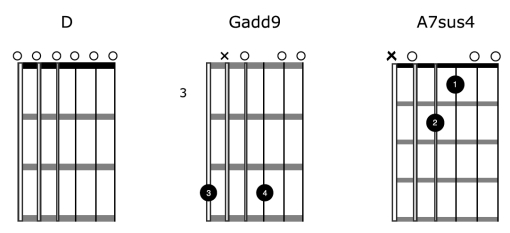
The equivalent chords in DADGAD tuning are very similar:
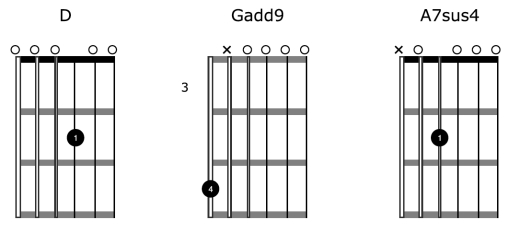
By extension, a progression played in Open D tuning such as this one:
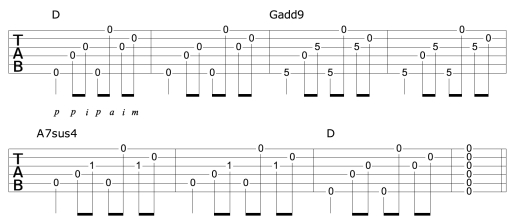
Will only need minor adjustments to be played in DADGAD tuning:
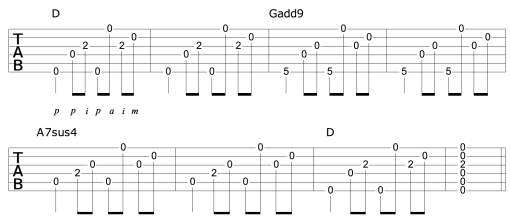
Due to this one false belief, I avoided playing my guitar in any kind of alternate tuning for years. To me, it was enough keeping on top of standard tuning. I wasn't prepared to let go of all the common chord shapes and scale patterns I had come to know so well, for a completely new fretboard.
Unfortunately I had the view of many guitarists that learning to play your guitar in any kind of tuning, other than standard, means having to start all over from the beginning.
This just isn't true! So don't let it stop you, like it did me, from exploring the awesome, cool, and unique sounds available to you when playing in open tunings.
What you need to realise is that a lot of open tunings are closely related, not just to each other but to standard tuning too. Let's see how an open G tuning compares to standard tuning for example:
Standard Tuning - E A D G B E
Open G Tuning - D G D G B D
As you can see, 50% of standard tuning remains unchanged with only the 6th, 5th, and 1st strings being altered. Therefore, much of the fretboard will still be familiar to you.
What about tunings that aren't so closely related to standard? Well, keep in mind learning in an open tuning does not cause the technique you have already developed to play a guitar to disappear. So regardless of how the new tuning relates to standard, it can never be like having to start playing from scratch as you still have your technique, which is a big part of your guitar playing.
Furthermore, open tunings set your guitar up to actually make things easier to play, not harder. If you ever try to play something written in an open tuning, in standard tuning, you'll see exactly what I mean.
For example, a bar chord in Open G tuning is a lot easier to play compared to standard tuning:
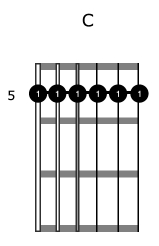
This allows a shuffle pattern, such as the one below, a lot easier to play than it would be in standard tuning:

Single fret bar chords also make certain embellishments possible to do that would not be available to you in standard tuning. Here is an example:

Many open tunings are very symmetrical making riffs and scale runs easy to play, as they fall nicely under your fingers.
One such tuning is Csus2 tuning:
Csus2 Tuning - CGCGCD
This tuning is quite symmetrical with alternating C and G notes with the exception of the top D. Not only this, but you only have 3 strings to learn C, G, and D. Compare that to the 5 strings of standard tuning E, A, D, G, and B.
Here are some ideas in Csus2 tuning to get you started:


Play around with these and create your own variations. Play them over a backing track in C major for some context. You'll come up with some pretty cool stuff by applying these ideas in this way.
If you are a little hesitant jumping into open tunings, or you want to take things a little slower, drop D tunings can be a great way to do this. With drop D tunings you simply drop either the low or high E strings of your guitar down to a D note.
Dropping the 6th string down to a D note is the more common of the two, and considering that open tunings such as open G, open D, and DADGAD all have D notes as their low and high strings, exploring drop D tunings first will make the transition over into open tunings a much smoother and even easier one.
Always remember that open tunings exist to make certain things on your guitar easier to play. Don't get me wrong, this does not mean that standard tuning is redundant as each tuning has it's place, and unique characteristics of course, but try playing a bar chord in standard tuning verses an open G tuning and tell me which one is easier to play.
If you have at least basic techniques down such as strumming, chord changes etc, you can sound great straight away in any open tuning. Let's use DADGAD to demonstrate just how easy it is to be up and playing
instantly:

Playing melodies on the top string while droning the low D string in DADGAD tuning sounds great! You could improvise forever on this idea alone. It can also extend to other strings, but for now I've limited it to the top string. Harmonics are also very effective in open tunings, as you can hear at the end of the example above.
Don't feel like you have to become an expert in open tunings to use them in your playing. You may only want to use them here and there, which is fine. On the contrary you may really get into them and use them all the time.
Whatever you do, don't avoid them altogether as I did, believing they are too hard and complicated. There's just too much you leave on the table regarding the sounds and possibilities that come with open tunings for your acoustic guitar playing if you do this.
Learn the magic of DADGAD tuning for acoustic guitar and all its wonderful
possibilities with this ebook/audio.
Specializing in online acoustic guitar lessons, Simon Candy is based in Melbourne, Australia where he runs his own guitar school.